Manufacturing of Clayey Bricks by Synergistic Use of Waste Brick and Ceramic Powders as Partial Replacement of Clay
Abstract
:1. Introduction
- (a)
- Properties of raw material used
- (b)
- Manufacturing techniques
- (c)
- Temperature
2. Materials and Methods
3. Results and Discussion
3.1. XRD of Brick Specimens
3.2. Physical Properties
3.2.1. Density
3.2.2. Porosity
3.3. Durability Properties
3.3.1. Water Absorption
3.3.2. Initial Rate of Water Absorption
3.3.3. Efflorescence
3.3.4. Sulfate Attack
3.3.5. Freeze and Thaw
3.3.6. Chemical Resistance of Bricks
3.4. Mechanical Properties
3.4.1. Compressive Strength
3.4.2. Modulus of Rupture
4. Conclusions
- Bricks containing waste ceramic and brick powder were free of efflorescence and had equal resistance against chemical attack, as observed in the ASTM C67 standard test.
- Bricks containing 27% (15% WBP + 12% WCP) waste materials possessed the same density, porosity, and water absorption capacity as those containing 100% clay.
- Bricks containing 27% (15% WBP + 12% WCP) waste materials possessed a 27% decreased initial water absorption rate compared to the control specimens.
- Bricks with 9% (5% WBP + 4% WCP) waste materials had a compressive strength of 11 MPa, more than the control specimens with 9.8 MPa strength. However, bricks with 27% waste materials had a strength of 8.1 MPa.
- Bricks with 9% (5% WBP + 4% WCP) waste materials had a modulus of rupture of 3.32 MPa, more than that of the control specimens with 3.26 MPa strength. However, bricks with 27% waste materials had a strength of 1.84 MPa.
- The combination of waste brick and ceramic powder was effective against sulfate attack, and the resistance increased with an increase in the replacement level.
- Bricks with 9% (5% WBP + 4% WCP) waste materials showed the highest resistance against freeze and thaw (only 0.87% weight loss). Nevertheless, the weight loss in all the specimens was found to be less than 1%.
Author Contributions
Funding
Institutional Review Board Statement
Informed Consent Statement
Data Availability Statement
Acknowledgments
Conflicts of Interest
References
- Horta, I.M.; Camanho, A.S.; Johnes, J.; Johnes, G. Performance trends in the construction industry worldwide: An overview of the turn of the century. J. Product. Anal. 2013, 39, 89–99. [Google Scholar] [CrossRef]
- Khitab, A.; Anwar, W. Advanced Research on Nanotechnology for Civil Engineering Applications; IGI Global: Hershey, PA, USA, 2016; pp. 1–27. [Google Scholar]
- Aakash, S.P. Engineering Properties of Clay Bricks with Use of Ash. Int. J. Res. Eng. Technol. 2014, 3, 75–80. [Google Scholar] [CrossRef]
- Riaz, M.H.; Khitab, A.; Ahmad, S.; Anwar, W.; Arshad, M.T. Use of ceramic waste powder for manufacturing durable and eco-friendly bricks. Asian J. Civ. Eng. 2019. [Google Scholar] [CrossRef]
- Cultrone, G.; Sebastián, E.; Elert, K.; de la Torre, M.J.; Cazalla, O.; Rodriguez–Navarro, C. Influence of mineralogy and firing temperature on the porosity of bricks. J. Eur. Ceram. Soc. 2004, 24, 547–564. [Google Scholar] [CrossRef]
- Singh, G. Building Construction and Materials; Standard Book House: Delhi, India, 2018. [Google Scholar]
- Ion, R.-M.; Fierascu, R.-C.; Teodorescu, S.; Fierascu, I.; Bunghez, I.-R.; Turcanu-Carutiu, D.; Ion, M.-L. Clays, Clay Minerals and Ceramic Materials Based on Clay Minerals; InTech: London, UK, 2016; pp. 159–184. [Google Scholar]
- Cultrone, G.; Sidraba, I.; Sebastian, E. Mineralogical and physical characterization of the bricks used in the construction of the bTriangul BastionQ, Riga (Latvia). Appl. Clay Sci. 2005, 28, 297–308. [Google Scholar] [CrossRef]
- Andreola, F.; Lancellotti, I.; Manfredini, T.; Bondioli, F.; Barbieri, L. Rice Husk Ash (RHA) Recycling in Brick Manufacture: Effects on Physical and Microstructural Properties. Waste Biomass Valorization 2018, 9, 2529–2539. [Google Scholar] [CrossRef]
- Kazmi, S.M.S.; Abbas, S.; Munir, M.J.; Khitab, A. Exploratory study on the effect of waste rice husk and sugarcane bagasse ashes in burnt clay bricks. J. Build. Eng. 2016, 7, 372–378. [Google Scholar] [CrossRef]
- Ibrahim, J.E.F.M.; Tihtih, M.; Gömze, L.A. Environmentally-friendly ceramic bricks made from zeolite-poor rock and sawdust. Constr. Build. Mater. 2021, 297, 123715. [Google Scholar] [CrossRef]
- Ahmad, S.; Iqbal, Y.; Muhammad, R. Effects of coal and wheat husk additives on the physical, thermal and mechanical properties of clay bricks. Bol. Soc. Esp. Ceram. Vidr. 2017, 56, 131–138. [Google Scholar] [CrossRef]
- Munir, M.J.; Abbas, S.; Nehdi, M.L.; Kazmi, S.M.S.; Khitab, A. Development of eco-friendly fired clay bricks incorporating recycled marble powder. J. Mater. Civ. Eng. 2018, 30. [Google Scholar] [CrossRef]
- Mandal, A.K.; Sinha, O.P. Preparation and Characterization of Fired Bricks Made from Bottom Ash and Iron Slime. J. Mater. Civ. Eng. 2017, 29, 4016245. [Google Scholar] [CrossRef]
- Hasan, M.R.; Siddika, A.; Akanda, M.P.A.; Islam, M.R. Effects of waste glass addition on the physical and mechanical properties of brick. Innov. Infrastruct. Solut. 2021, 6, 36. [Google Scholar] [CrossRef]
- Li, R.; Zhou, Y.; Li, C.; Li, S.; Huang, Z. Recycling of industrial waste iron tailings in porous bricks with low thermal conductivity. Constr. Build. Mater. 2019, 213, 43–50. [Google Scholar] [CrossRef]
- Jiménez-Quero, V.G.; Guerrero-Paz, J.; Ortiz-Guzmán, M. Alternatives for improving the compressive strength of clay-based bricks. J. Phys. Conf. Ser. 2021, 1723, 012027. [Google Scholar] [CrossRef]
- Jordan, M.M.; Montero, M.A.; Meseguer, S.; Sanfeliu, T. Influence of firing temperature and mineralogical composition on bending strength and porosity of ceramic tile bodies. Appl. Clay Sci. 2008, 42, 266–271. [Google Scholar] [CrossRef]
- Montero, M.A.; Jordán, M.M.; Hernández-Crespo, M.S.; Sanfeliu, T. The use of sewage sludge and marble residues in the manufacture of ceramic tile bodies. Appl. Clay Sci. 2009, 46, 404–408. [Google Scholar] [CrossRef]
- Montero, M.; Jordan, M.; Almendrocandel, M.; Sanfeliu, T.; Hernandezcrespo, M. The use of a calcium carbonate residue from the stone industry in manufacturing of ceramic tile bodies. Appl. Clay Sci. 2009, 43, 186–189. [Google Scholar] [CrossRef]
- Riaz, M.H.; Khitab, A.; Ahmed, S. Evaluation of sustainable clay bricks incorporating Brick Kiln Dust. J. Build. Eng. 2019, 24, 100725. [Google Scholar] [CrossRef]
- Munir, M.J.; Kazmi, S.M.S.; Wu, Y.-F.; Hanif, A.; Khan, M.U.A. Thermally efficient fired clay bricks incorporating waste marble sludge: An industrial-scale study. J. Clean. Prod. 2018, 174, 1122–1135. [Google Scholar] [CrossRef]
- Kazmi, S.M.S.; Munir, M.J.; Wu, Y.-F.; Hanif, A.; Patnaikuni, I. Thermal performance evaluation of eco-friendly bricks incorporating waste glass sludge. J. Clean. Prod. 2018, 172, 1867–1880. [Google Scholar] [CrossRef]
- Vyšvařil, M.; Rovnaníková, P.; Keppert, M. Rheological Properties of Alkali-Activated Brick Powder Based Pastes: Effect of Alkali Activator and Silicate Modulus. Solid State Phenom. 2018, 276, 185–191. [Google Scholar] [CrossRef]
- Material-Specifications. Available online: http://cwd.gkp.pk/images/CSR/Material-Specifications-MRS-KPK-2020.pdf (accessed on 9 September 2021).
- Pakistan Engineering Council. Standardization of Building Codes, Standards and Specifications for Low-Cost (Affordable) Units. Available online: https://pec.org.pk/downloads/Standardization%20of%20Building%20Codes,%20Standards%20and%20Specifications%20for%20Low-Cost%20(Affordable)%20Units-2021.pdf (accessed on 7 September 2021).
- ASTM C67/C67M-21. Standard Test Methods for Sampling and Testing Brick and Structural Clay Tile; ASTM International: West Conshohocken, PA, USA, 2014. [Google Scholar]
- ASTM C1012/C1012M-15. Standard Test Method for Length Change of Hydraulic-Cement Mortars Exposed to a Sulfate Solution; ASTM International: West Conshohocken, PA, USA, 2015; pp. 5–9. [Google Scholar]
- Ahmed, M.; Mallick, J.; Hasan, M.A. A study of factors affecting the flexural tensile strength of concrete. J. King Saud Univ. Eng. Sci. 2016, 2016, 147–156. [Google Scholar] [CrossRef] [Green Version]
- ASTM C20-00. Standard Test Methods for Apparent Porosity, Water Absorption, Apparent Specific Gravity, and Bulk Density of Burned Refractory Brick and Shapes by Boiling Water; ASTM International: West Conshohocken, PA, USA, 2015. [Google Scholar]
- Sutcu, M.; Alptekin, H.; Erdogmus, E.; Er, Y.; Gencel, O. Characteristics of fired clay bricks with waste marble powder addition as building materials. Constr. Build. Mater. 2015, 82, 1–8. [Google Scholar] [CrossRef]
- Abhilash, J. IS: 875 (Part 1)—1987 Indian Standard PART 1 DEAD LOADS—UNIT WEIGHTS OF BUILDING MATERIALS AND STORED MATERIALS B U R E A U O F I N D I A N S T A N D A R D S. Available online: https://www.academia.edu/6224449/IS_875_Part_1_1987_Indian_Standard_PART_1_DEAD_LOADS_UNIT_WEIGHTS_OF_BUILDING_MATERIALS_AND_STORED_MATERIALS_B_U_R_E_A_U_O_F_I_N_D_I_A_N_S_T_A_N_D_A_R_D_S (accessed on 7 September 2021).
- Khitab, A. Finite Element Analysis of Structural Concrete Insulated Panels Subjected to Dynamic Loadings. Civ. Eng. Beyond Limits 2020, 1, 31–37. [Google Scholar] [CrossRef]
- Bakar, B.H.A.; Saari, S.; Surip, N.A. Water absorption characteristic of interlocking compressed earth brick units. AIP Conf. Proc. 2017, 1892, 020018. [Google Scholar] [CrossRef]
- ASTM C62-13. Standard Specification for Building Brick (Solid Masonry Units Made from Clay or Shale); ASTM International: West Conshohocken, PA, USA, 2013. [Google Scholar]
- Pavía, S.; Hanley, R. Flexural bond strength of natural hydraulic lime mortar and clay brick. Mater. Struct. 2010, 43, 913–922. [Google Scholar] [CrossRef] [Green Version]
- Khitab, A.; Lorente, S.; Ollivier, J.P. Predictive model for chloride penetration through concrete. Mag. Concr. Res. 2005, 57, 511–520. [Google Scholar] [CrossRef]
- Stryszewska, T.; Kańka, S. Forms of Damage of Bricks Subjected to Cyclic Freezing and Thawing in Actual Conditions. Materials 2019, 12, 1165. [Google Scholar] [CrossRef] [Green Version]
- Akinyele, J.O.; Igba, U.T.; Ayorinde, T.O.; Jimoh, P.O. Structural efficiency of burnt clay bricks containing waste crushed glass and polypropylene granules. Case Stud. Constr. Mater. 2020, 13, e00404. [Google Scholar] [CrossRef]
- Sharma, N.; Telang, D.; Rath, B. A Review on Strength of Clay Brick Masonry. Int. J. Res. Appl. Sci. Eng. Technol. 2017, 5, 2620–2626. [Google Scholar]
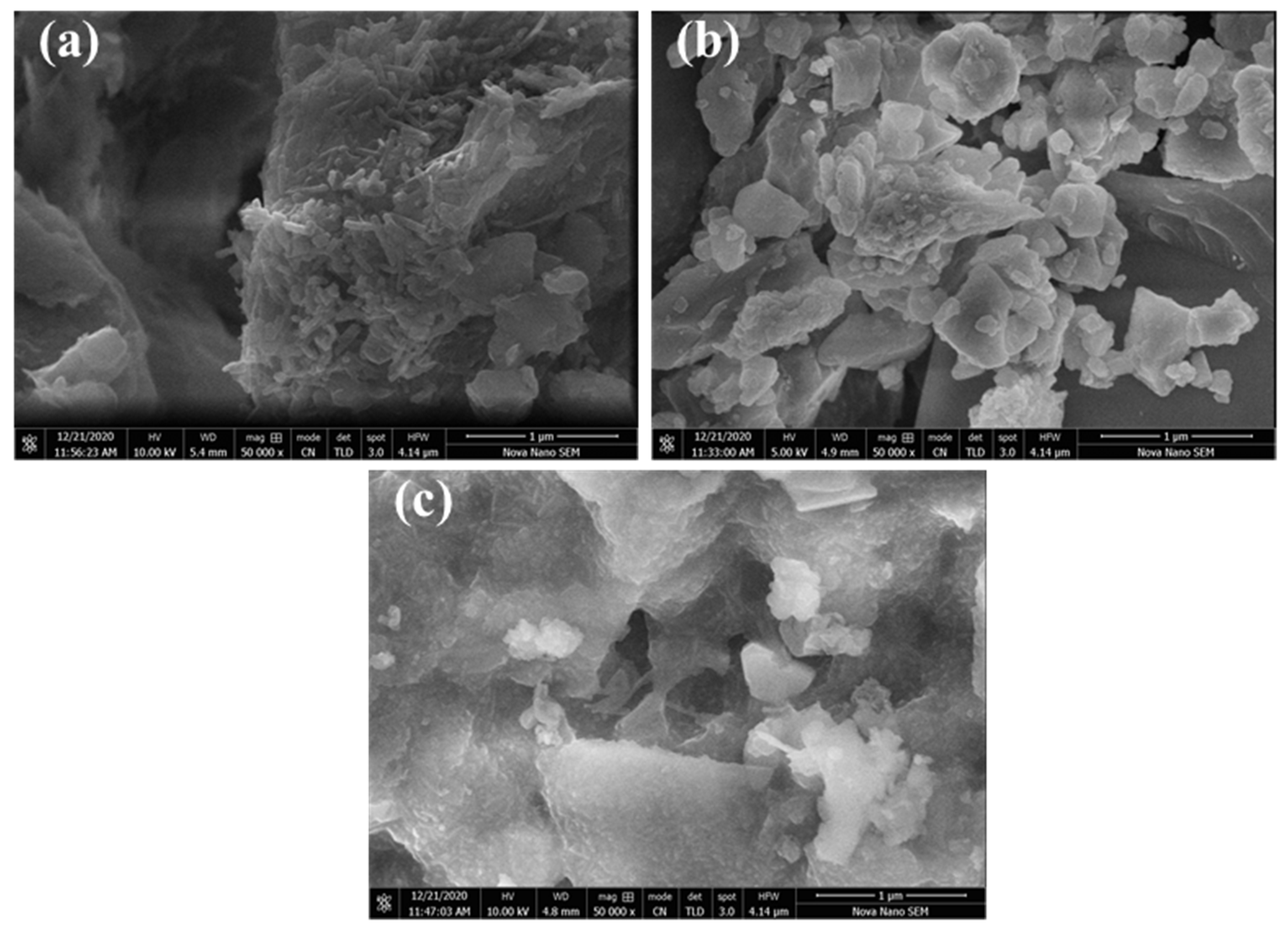
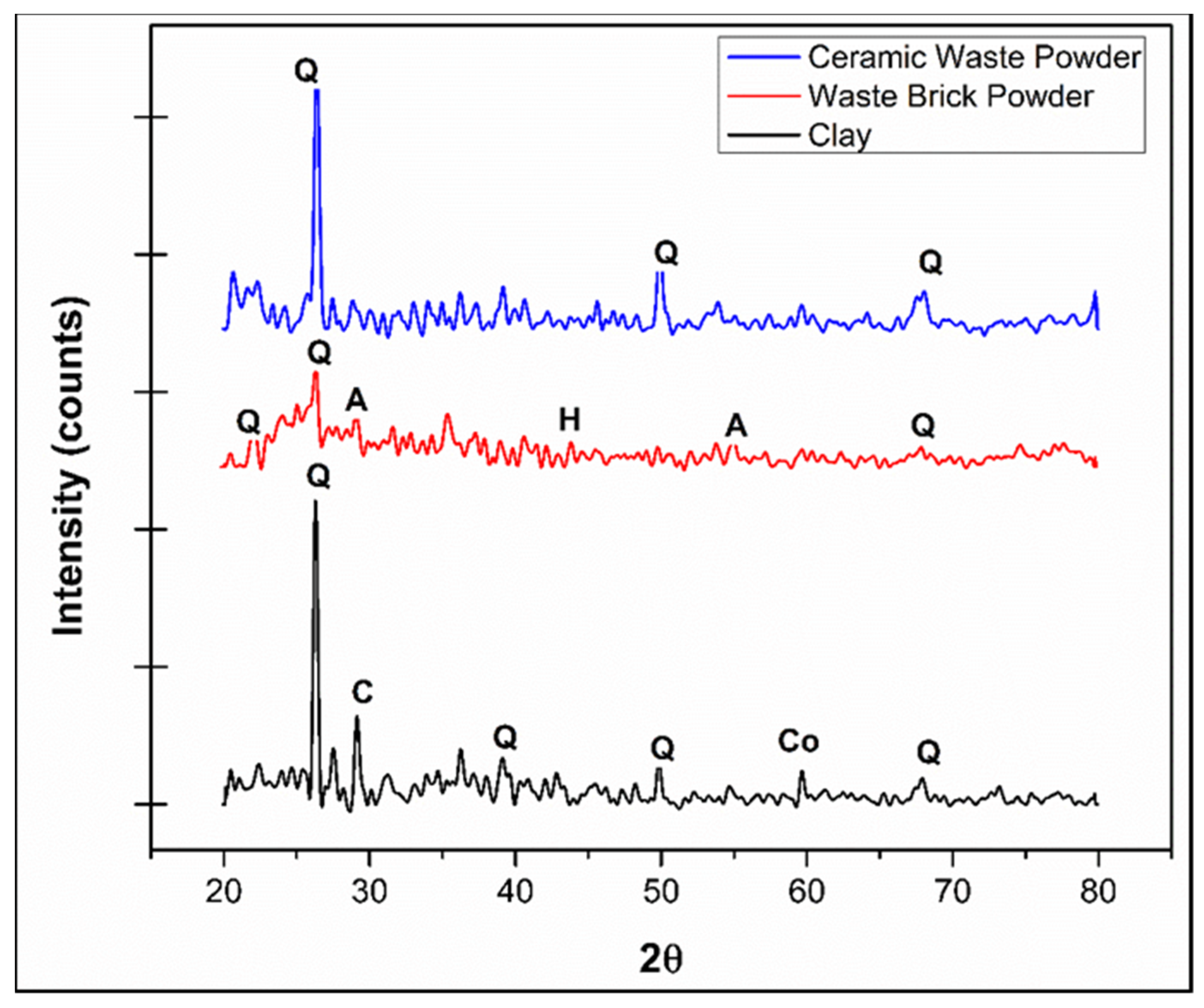

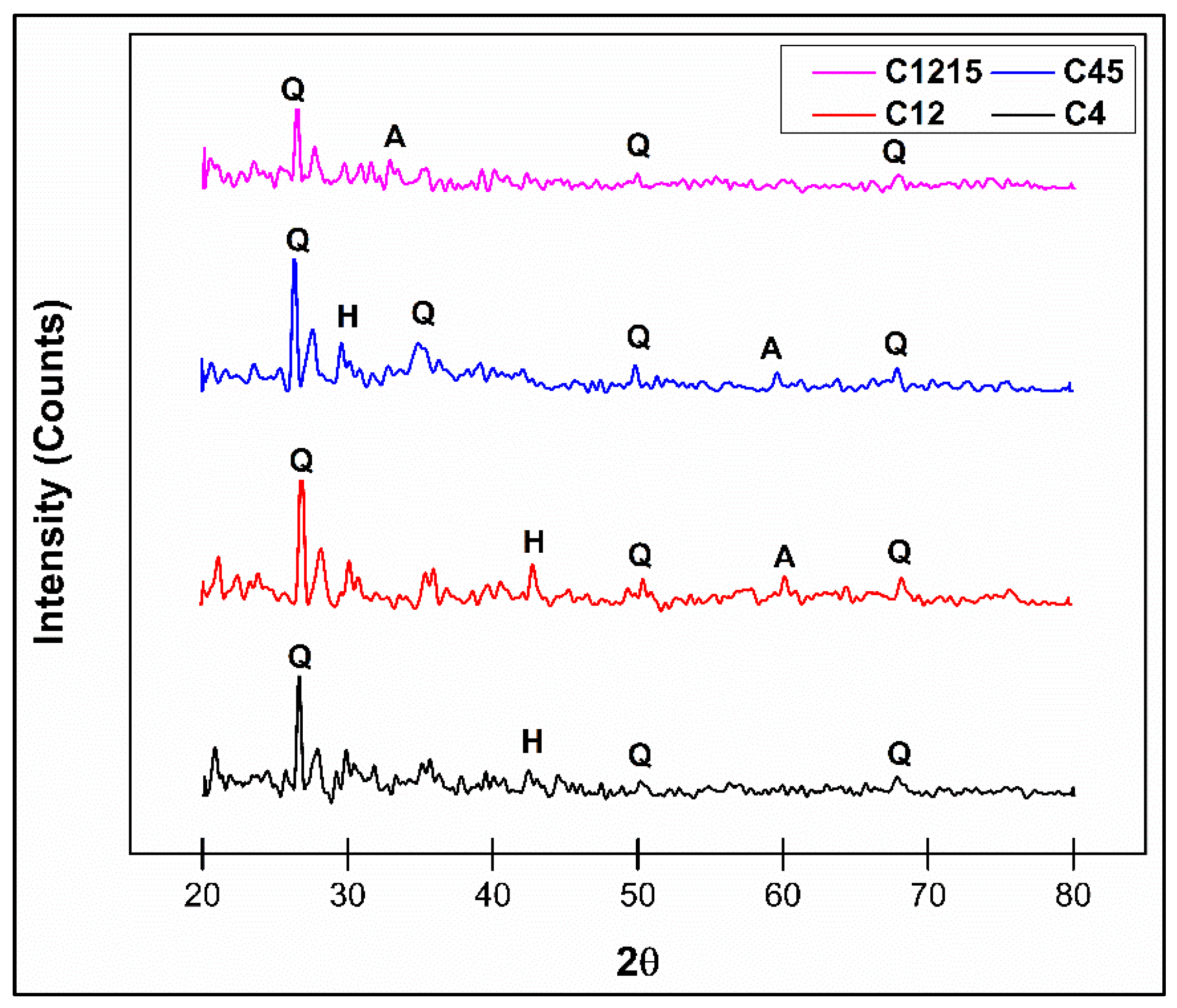

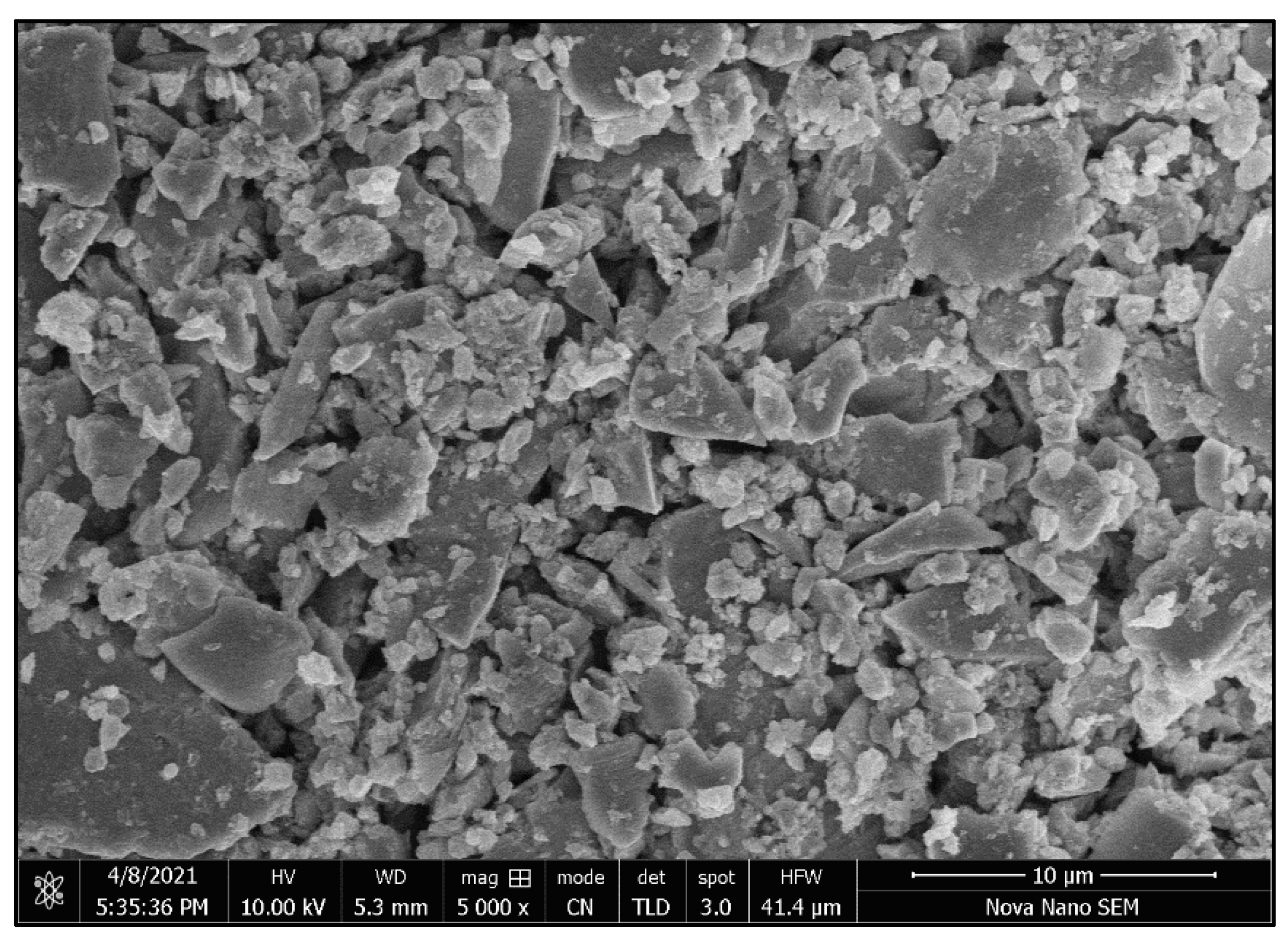
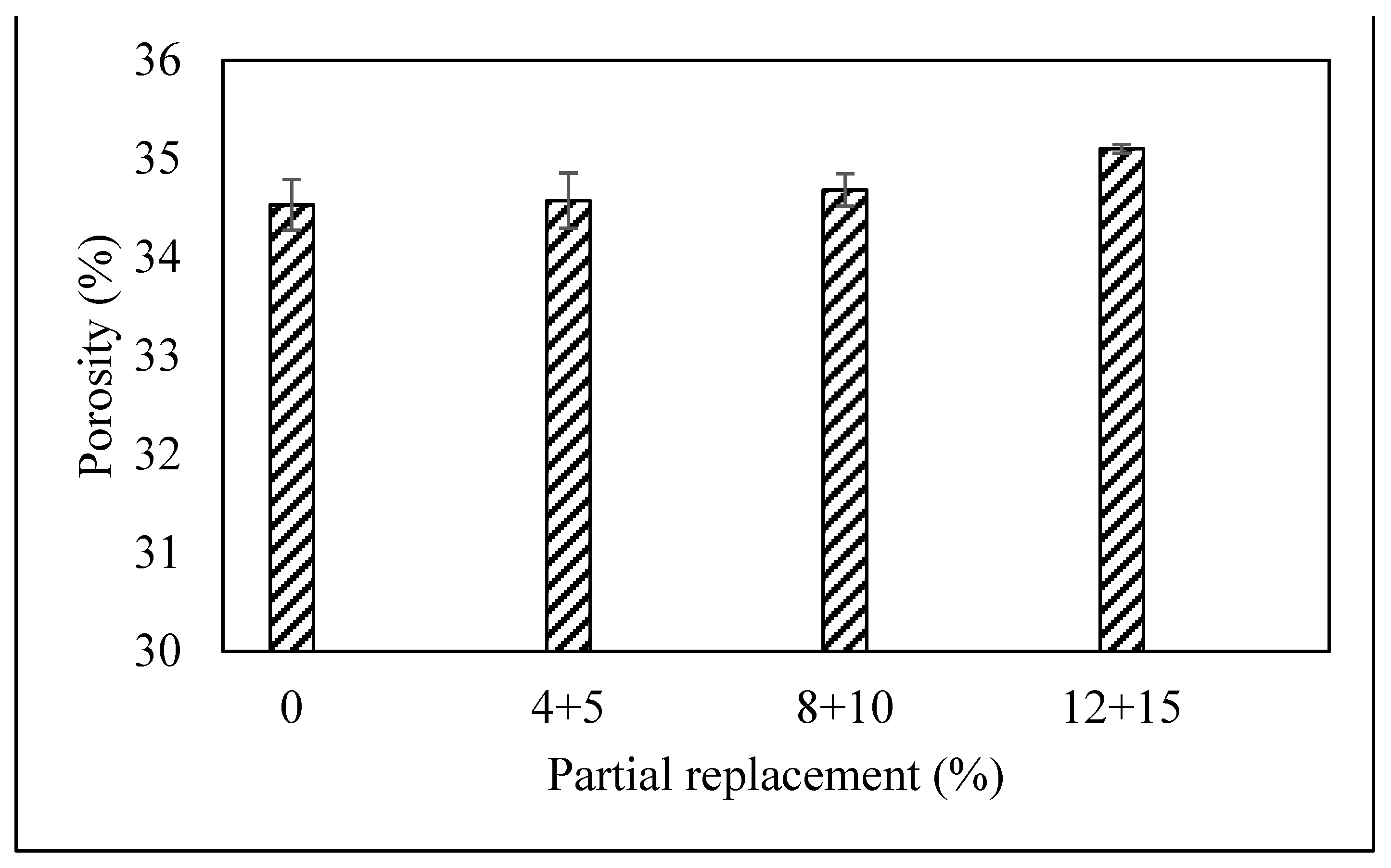

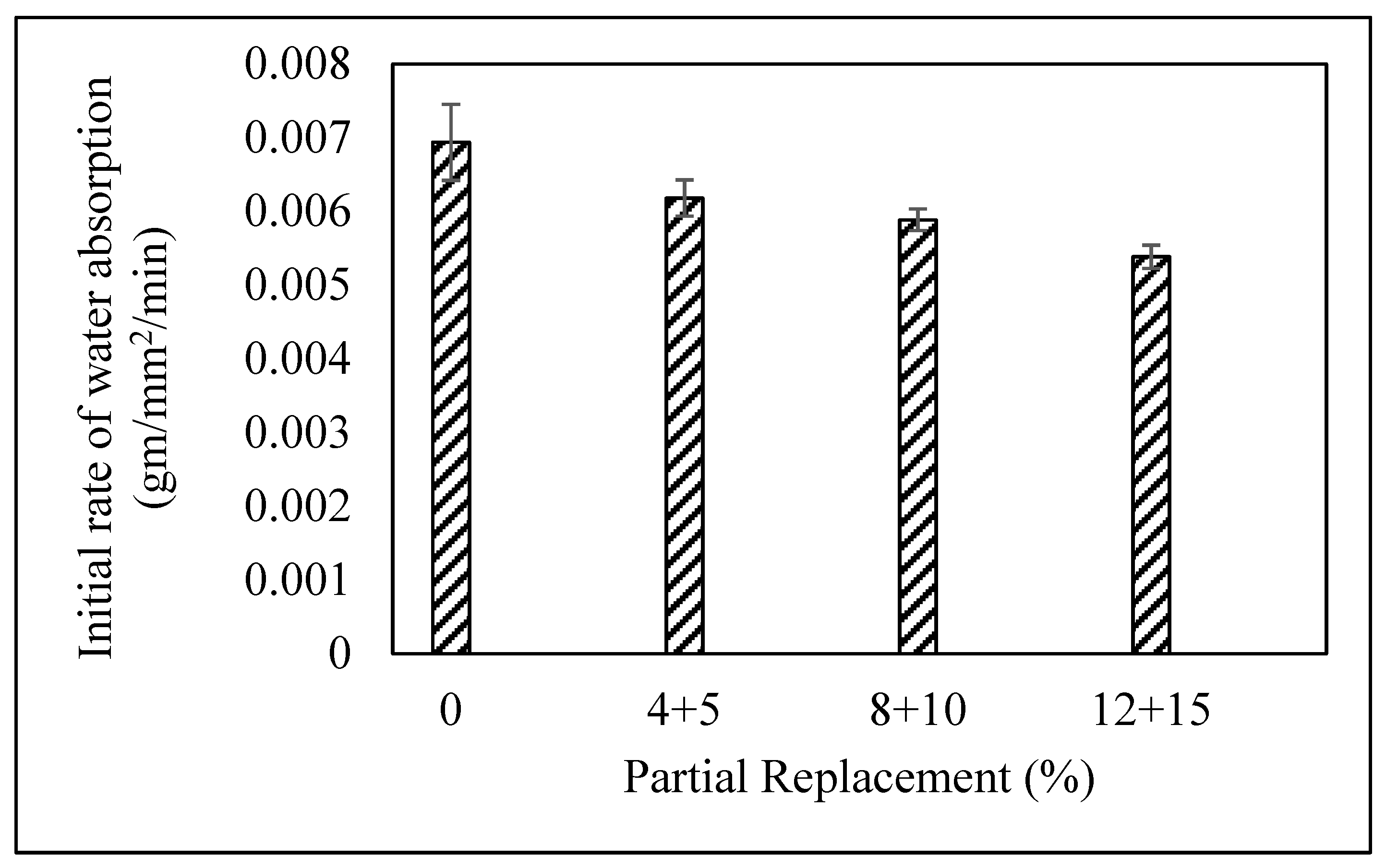
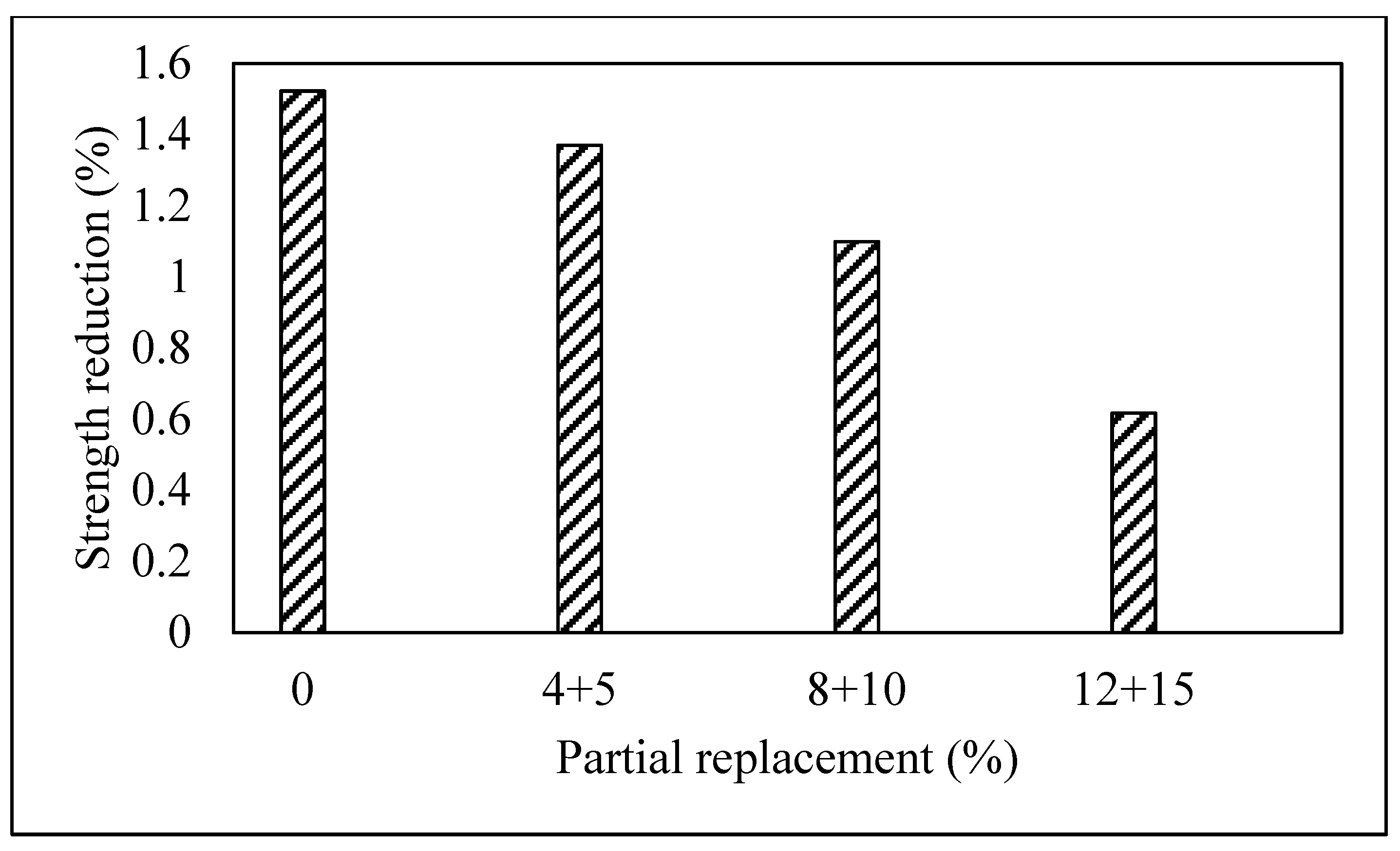

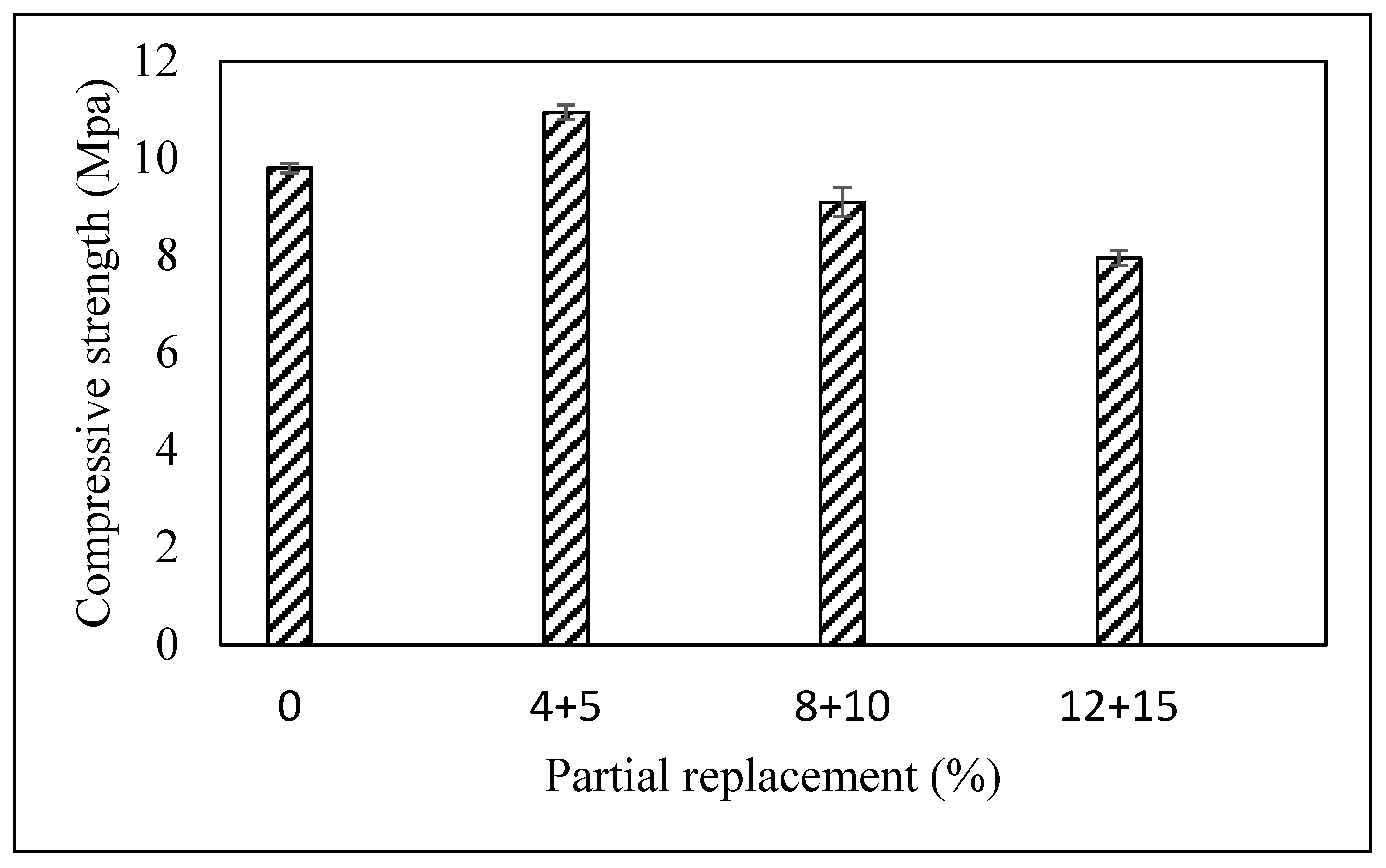
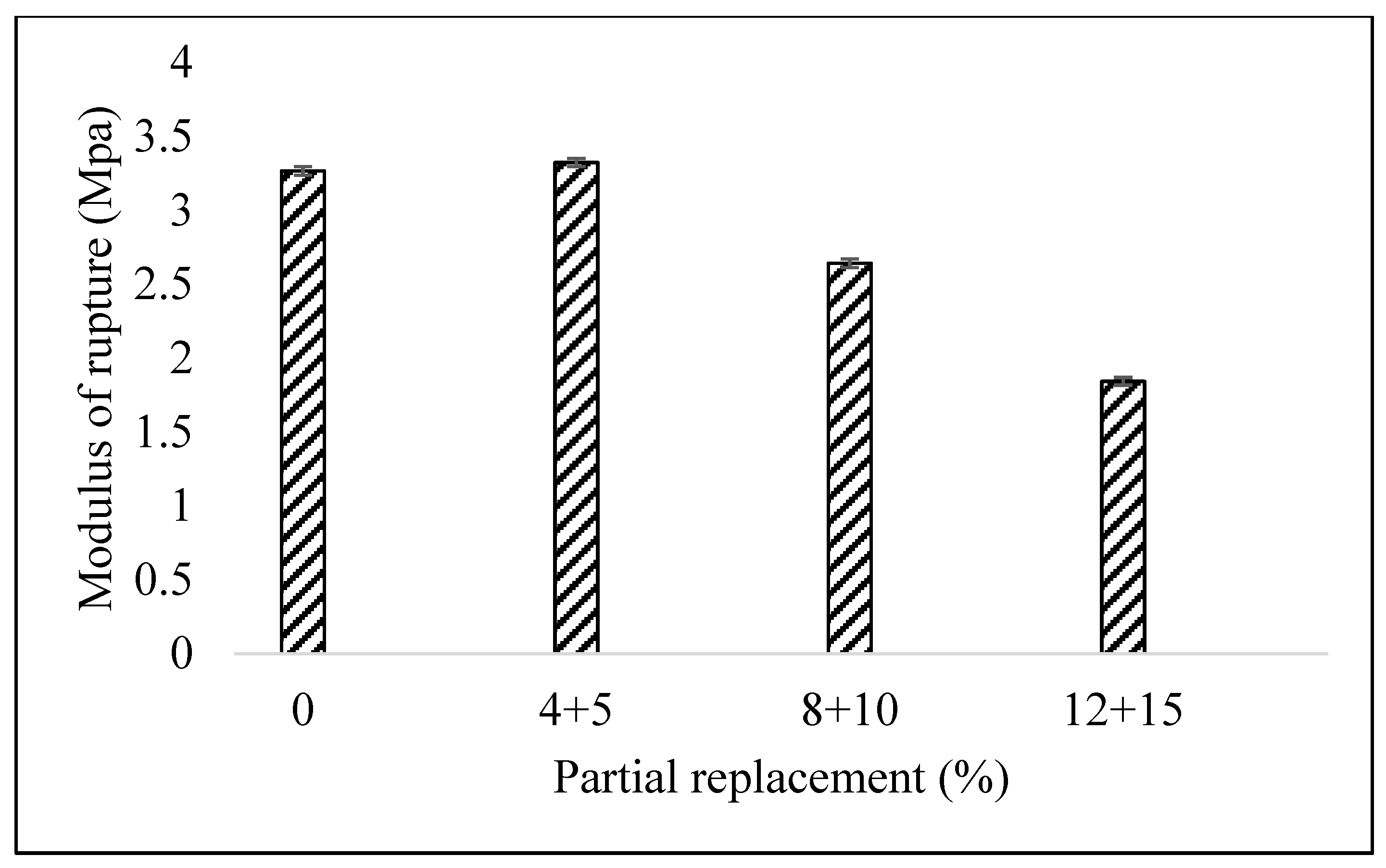
| Clay | WCP | WBP | Recommended for Bricks [4] | |
|---|---|---|---|---|
| SiO2 | 59.227 | 71.004 | 46.362 | 50–60 |
| Al2O3 | 16.608 | 21.877 | 29.723 | 20–30 |
| Fe2O3 | 6.947 | 1.169 | 7.78 | 5–6 |
| SO3 | - | - | 5.174 | - |
| CaO | 13.108 | 3.682 | 4.858 | 1–5 |
| TiO2 | 0.885 | 1.104 | 3.929 | - |
| K2O | 2.92 | 0.374 | 1.86 | - |
| Scheme | Name | Clay (%) | (WCP + WBP) (%) | No. of Bricks |
|---|---|---|---|---|
| 5 | C45 | 91 | 4 + 5 | 50 |
| 6 | C810 | 82 | 8 + 10 | 50 |
| 7 | C1215 | 73 | 12 + 15 | 50 |
Publisher’s Note: MDPI stays neutral with regard to jurisdictional claims in published maps and institutional affiliations. |
© 2021 by the authors. Licensee MDPI, Basel, Switzerland. This article is an open access article distributed under the terms and conditions of the Creative Commons Attribution (CC BY) license (https://creativecommons.org/licenses/by/4.0/).
Share and Cite
Khitab, A.; Riaz, M.S.; Jalil, A.; Khan, R.B.N.; Anwar, W.; Khan, R.A.; Arshad, M.T.; Kirgiz, M.S.; Tariq, Z.; Tayyab, S. Manufacturing of Clayey Bricks by Synergistic Use of Waste Brick and Ceramic Powders as Partial Replacement of Clay. Sustainability 2021, 13, 10214. https://doi.org/10.3390/su131810214
Khitab A, Riaz MS, Jalil A, Khan RBN, Anwar W, Khan RA, Arshad MT, Kirgiz MS, Tariq Z, Tayyab S. Manufacturing of Clayey Bricks by Synergistic Use of Waste Brick and Ceramic Powders as Partial Replacement of Clay. Sustainability. 2021; 13(18):10214. https://doi.org/10.3390/su131810214
Chicago/Turabian StyleKhitab, Anwar, Muhammad Saqib Riaz, Affan Jalil, Raja Bilal Nasar Khan, Waqas Anwar, Riaz Akhtar Khan, Muhammad Tausif Arshad, Mehmet Serkan Kirgiz, Zeesshan Tariq, and Seemab Tayyab. 2021. "Manufacturing of Clayey Bricks by Synergistic Use of Waste Brick and Ceramic Powders as Partial Replacement of Clay" Sustainability 13, no. 18: 10214. https://doi.org/10.3390/su131810214
APA StyleKhitab, A., Riaz, M. S., Jalil, A., Khan, R. B. N., Anwar, W., Khan, R. A., Arshad, M. T., Kirgiz, M. S., Tariq, Z., & Tayyab, S. (2021). Manufacturing of Clayey Bricks by Synergistic Use of Waste Brick and Ceramic Powders as Partial Replacement of Clay. Sustainability, 13(18), 10214. https://doi.org/10.3390/su131810214







